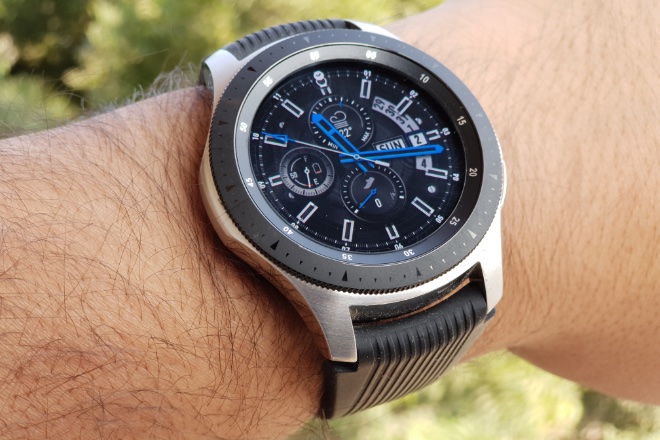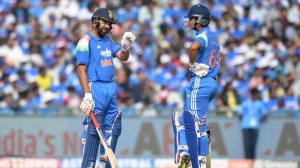Samsung has always made sure that there is no vacuum in the variety of consumer products it offers under the Galaxy umbrella. The Galaxy Watch is another product that streamlines the delivery of the assurance Samsung has charged its Galaxy line with. The Samsung Galaxy Watch is the latest addition to the company’s wearable family that melds the experience with other members such as the smartphone and wireless earbuds more than ever. This time Samsung has experimented to a small degree by removing the ‘Gear’ from the name and going with the plain Galaxy Watch, presumably to make the buyers get an idea that it belongs with the Galaxy smartphone.
The idea of wearing smartwatches has still not culminated to the point where it becomes mainstream, yet the tech companies are not shying away from aggressively countering the rivals over them and believing that consumers will someday accept their utility. Samsung Galaxy Watch is a rather spruced up version of the last Galaxy Gear wearable. It has some new features, upgraded specifications, and a different design, yet one thing that has stayed constant is the software. The Galaxy Watch is powered by Samsung’s Tizen OS that is still finding its missing pieces to venture back into the smartphone realm.
No matter how relatively cheaper the Samsung flagship products are, they are inevitably going to be pitted against the other top-notch products, by which we mean the Apple Watch. The Apple Watch Series 4 is Apple’s most powerful smartwatch to date featuring ECG capability for the first time in a consumer product. Samsung too has many body-related functions that it boasts of. The Samsung Galaxy Watch costs Rs 24,990 for the 42mm variant and Rs 29,990 for the 46mm model, both lacking the LTE capability. The Apple Watch Series 4, on the other hand, costs Rs 40,990 for the base 40mm variant. Can Samsung Galaxy Watch fulfil your desire to own an Apple Watch for far less money? Read our review.
Samsung Galaxy Watch: Design, Display, and Hardware
The first two things that you are likely to notice about the Samsung Galaxy Watch are the bezel and the display that makes it look like a regular wristwatch. The unit we received is the 46mm model that offers a relatively larger real estate, which could be optimal for users with thick fingers. It is only available in a single Silver colour variant, which looks elegant. The 42mm model comes in two colours – Midnight Black and Rose Gold. People with thin wrists may as well go for the 42mm variant.
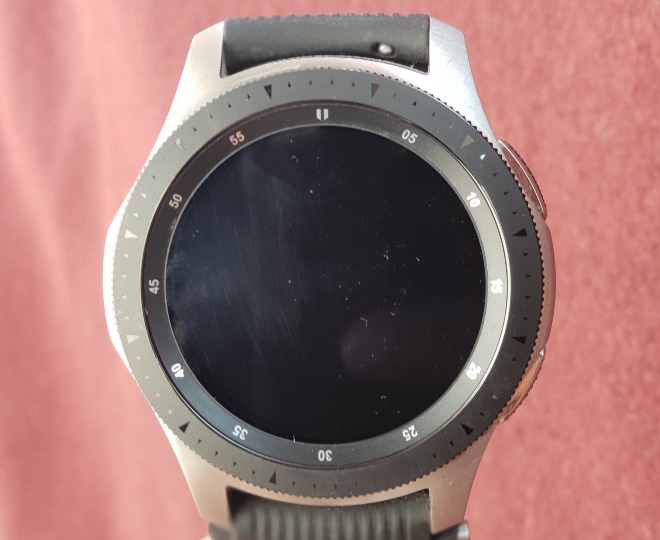
While the design of a watch is something that is preferential, you will mostly find people wearing the round-shaped ones, which is why Samsung has gone with the majority by opting for the same design on the Galaxy Watch. The build of the Galaxy Watch is divided into two parts – the dial and the strap. First up is the dial that is round and thick. It has a metallic bezel on the top that is rotatable – it gives a tactile feedback on every rotation that feels satisfying. The rotations – clockwise and anticlockwise – let you interact with the watch’s interface without having to touch the display. There are markings that have been subtly carved on the bezel to denote the seconds. The greyish accent of these marking blends well with the dial. Overall, the Galaxy Watch is not much of a looker, still manages to draw attention due to its odd similarity to regular wristwatches.
The strap is based on silicone material, which is highly prone to dust. While the durability of the strap is one thing, its tendency to add to the watch’s beauty is what you should consider before choosing it. We were not comfortable wearing the strap for a long time – also, it is definitely not sleep-friendly. There are two other straps available for the Galaxy Watch – a leather strap and a stainless steel strap. The latter is pricier, of course. The buckle of the watch is clasped easily, however, unfastening it from the adjustment holes is not as comfortable as you would expect.
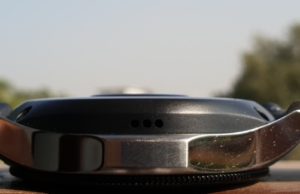
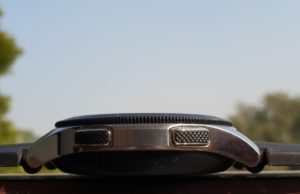
There are two physical buttons and a microphone given on the right edge while the left edge houses the speaker grille. The buttons feel sturdy and have a nice finish to them – there’s a textured matte finish given to the top portions while steel trims cover the lower portions. The buttons are clickable – the top one is the Back button while the bottom one is the Home/ Bixby button. On the bottom of the dial is the heart rate sensor that offers the most important feature on the Galaxy Watch.
The display is the centrepiece of the Galaxy Watch – it’s a 1.3-inch OLED display with a pixel density of 282 dpi. It is protected by a Corning Gorilla Glass DX+. The display is sharp and vibrant, the viewing angles are good, however, that’s not the best part about this display. The display can get really bright – even under direct sunlight, we did not have to squint our eyes to read notifications, texts, and other elements. It’s also an Always-On Display, but unlike the regular smartphone AOD, the Galaxy Watch shows colours on AOD.
Samsung has invested a good amount of efficiency in the Galaxy Watch to make it robust. The Galaxy Watch comes with IP68 water and dust resistance, which means you can freely wash your hands without having to worry about the splashes on the watch. The watch is capable of throwing the water out from the speakers, which is conspicuously the only place water can enter through, using a sound. Moreover, it even comes with the MIL-STD-810G rating for protection against drops and shocks, which we felt worked well. We did drop the watch accidentally and picked it up without any scratches or ding.
Samsung Galaxy Watch: Performance and Battery
The Samsung Galaxy Watch is powered by a dual-core Exynos 9110 processor clocked at 1.15GHz. The day-to-day multitasking on the Galaxy Watch is smooth – there were no hiccups in the daily operation. The smartwatch runs Tizen – there’s an odd reason as to why Samsung has reluctantly stayed away from Google’s Wear OS after the first edition Galaxy Gear smartwatch ran Android – the company is pushing the self-sustenance for its ecosystem on at least one device after losing bets on smartphones to counter the entry-level mobile operating systems. We won’t say Tizen is as resourceful as Wear OS or watchOS, but it does everything a smartwatch is supposed to, except for support for popular apps such as Uber.
If you have an Android phone, preferably a Samsung Galaxy device, the Galaxy Watch is best-suited but iPhone users can buy it too, however, it doesn’t make a lot of sense. Pairing the Galaxy Watch with an Android phone will allow it to work to the fullest that includes making and answering calls, reading and responding to the notifications from nearly all the apps that offer interaction within the notification shade. On an iPhone, everything works except replying to the notifications. You will need to download the Gear Wearable app from the respective app marketplace to initiate the pairing process – something that pulls down the standalone properties on smartwatches, more so because of the need to download and install plugins for most services.

The Galaxy Watch comes in two variants in terms of connectivity – Bluetooth and LTE. The former uses Bluetooth for pairing with the smartphone that enables mirroring calls, notifications, and other things on the watch’s ecosystem. The latter, however, offers a completely standalone experience because of the SIM support. It doesn’t really need the phone to stay in proximity to fetch notifications and call information. Sadly, the Galaxy Watch LTE version is not available in India, which is strange given that Apple Watch is available in the LTE version, thanks to the eSIM infrastructure provided by Reliance Jio and Airtel.
There is another difference between the two variants – the RAM capacity. The Bluetooth version has 768MB of RAM while the LTE version has nearly twice as much RAM with 1.5GB. Since we didn’t have access to the latter, we cannot tell how much of an improved performance it has over the former. There is 4GB of onboard storage available, however, only 1.5GB is what is available for use. This storage is used to install apps, store photos, music, and data such as health information. Other connectivity options on the Galaxy Watch include GPS, Glonass, and NFC that, hardly, is of any use since Samsung Pay functionality on it isn’t enabled in India.
However unusual it may sound, Galaxy Watch can be used to play music, just like an MP3 player. The speakers are decently loud, considering a watch isn’t something you’d listen to music on. If you are not wooed by the idea of hearing music from the watch’s speakers, you can pair Bluetooth earphones. It’s something that we favourably liked on the Galaxy Watch, especially at the time of working out when having the phone dangling in the pocket is not so convenient.
The biggest motto of a smartwatch is to replace the fitness band in entirety while offering additional productivity. The Galaxy Watch comes with a heart-rate sensor that adds up to the fitness suite available within the ecosystem. A level up from the previous generation, the Galaxy Watch can detect up to 40 different kinds of physical activities such as running, sleeping, walking, jogging, cycling, exercising, and even resting. While everything is at its place working the way it is likely expected to, we found the Galaxy Watch counting footsteps while we were in a public transport such as an e-rickshaw. It reminds to get up in certain intervals after it detects no movement for a longer time. The Galaxy Watch also tells you to do a Torso Twist rep when it detects you have been sitting longer than usual. The nice thing is that Galaxy Watch is smart enough to figure out if we actually did twist our upper body and not just the wrist.
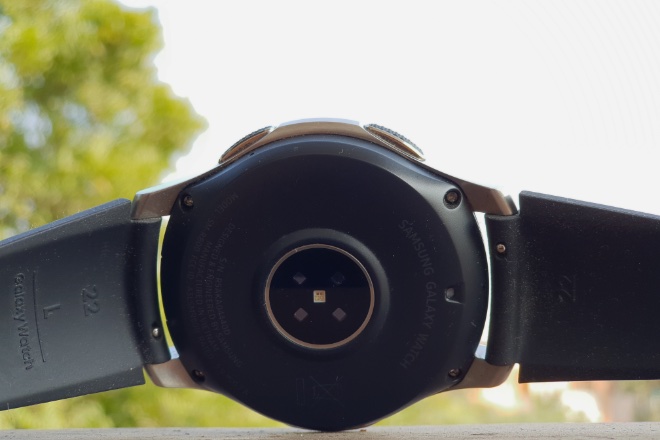
The steps counter works just fine with some error of the estimate sometimes. The heart rate sensor shows relevant heart-related data collected at various times of the day, which you can customise to just one time in a day or so forth, represents how healthy your heart remains after different activities. There is also a dedicated measurer for the stress level that not only records the stress but also suggests methods to relax.
Many people do not take off their fitness band/ smartwatch when they go to sleep, which brings us to how much suitable Galaxy Watch is for tracking sleep data. The Galaxy Watch detects various activities happening in our body to identify if it’s deep sleep or light. The smartwatch tells how long we remained motionless during the sleep, in addition to shedding light on the REM data, which is impressive.
However, this is just plain data that keeps getting logged into the Health app without any suggestions on how to improve the sleep. Also, the watch begins to cause discomfort while sleeping – it’s noticeably heavy considering you’d put on light things before going to bed. The green light flickering inside of the heart rate sensor at the bottom adds up to the distraction level the smartwatch already has. There is a Theater Mode on the smartwatch that silences all the notifications when the phone is still connected to it.
In addition to this, the daily intake of nutrients, water, and caffeine can also be recorded into the Samsung Health app that Galaxy Watch will use to suggest best workout regimes and health-related recommendations. While Samsung Health is a quite intuitive app and offers many features, most people would rather go for Google Fit, which, unfortunately, is not supported by Galaxy Watch.
The Galaxy Watch can be paired with the smartphone using the Galaxy Wear app. It’s available on both Android and iOS. The app offers some readymade settings and customisations that you would normally perform on the watch with some extra efforts. One thing that Samsung has paid attention to this time is the variety in the watch faces. There are some really good-looking watch faces that you will most likely prefer using about every alternate week. The app also lets customising the Home button so it can be remapped to launch an app from opening Bixby on double-click. Three clicks on the Home button will initiate an SOS emergency via connected phone.
Bixby, again, is something that we would not dedicate much time to, especially on a smartwatch when its smartphone counterpart is as much disappointing, at least in the Indian context. However, it deserves a mention for debuting on a smartwatch for the first time with Galaxy Watch. During our time with the Galaxy Watch, we frankly did not find ourselves actually feeling the need to wake Bixby. But, anyway, we did the testing and the results were as inglorious as expected. Out of multiple attempts, we made to make sure Bixby understands the voice correctly, two were on the point. General knowledge questions such as asking capitals were answered with an instruction for us to look at the phone for results, which, to our surprise, did never really appear on the phone.

The calls attended on the Galaxy Watch were clear and audible if you bring your ears near it, thanks to the microphone and speaker. However, this is not the best part about the calling experience on the Galaxy Watch – connect a Bluetooth headset, preferably one from Samsung, and experience how you can wirelessly respond to calls without even having to take your phone out of pocket in crowded places. The bezel is another way to answer calls – rotating it clockwise takes the calls while anticlockwise rotation declines them.
Responding to notifications is easy and smooth. If you have turned on sound alerts for notifications, the Galaxy Watch will ring everytime a notification arrives. We’d recommend turning just the vibration on for notifications – the vibrations are distinct enough to inform you that if it’s a call or a notification. We set the display light up only when it detects a change in the altitude, in laymen terms, when we raised our hands. If this is the setting you’ll likely use the most, the interactions with the notifications could become quite stressfree.
This is how it works – when a notification arrives, the display will only light up if you raise your hand, thereby, expanding the notification without having you to touch the screen or rotate the bezel.
WhatsApp, particularly, is very well supported on the Galaxy Watch. You can read all the new messages in list format and reply with some predefined message or create your own message using the on-screen T9 keyboard that has a clumsy flow. The keyboard has auto-suggestions turned on, which becomes an issue when typing Hindi words in English. You can also dictate Bixby what you want to write as a reply, but enough said about Bixby. Its best alternative is sending voice notes, much like you would on the phone.
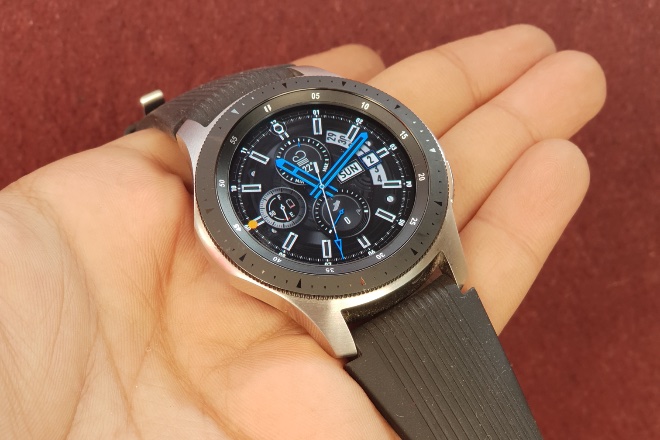
The Galaxy Watch has two different battery capacities as per its two models – the 42mm packs a 270mAh battery while the 46mm version has 472mAh battery that’s nearly twice as much. The battery life on the Galaxy Watch is impressive – we could go on using it on a single charge for more than four days, sometimes five if you conserve some power using the Power Saving Mode. Samsung has provided a wireless charging cradle for Galaxy Watch that is plugged into the main power source via regular adapter and MicroUSB cable. The rear side of the Galaxy Watch has to be slapped against the cradle’s inner surface. The wireless charging is slow, though. It takes around 2 hours 30 minutes for it charge to 100 per cent. This is significantly better than the batteries in Apple Watch models.
Verdict
The Samsung Galaxy Watch is full of features, although you may sometimes feel the absence of Wear OS. Most of the apps are supported on the Galaxy Watch with functionalities that are not compromised from any angle, whatsoever. Health tracking on the Galaxy Watch is something that you will be happily satisfied with. With some tradeoffs, the Galaxy Watch does a nice job of handling what smartwatches are primarily tasked to do. With a bit of everything, it aims to take on Apple Watch that is unmatched in the wearables segment to date. Having an impressive battery life as its strongest pursuit to fight off Wear OS wearables and Apple Watch, Samsung Galaxy Watch is here to capture some market, however, the pricing is something that can repel many potential customers.
The Galaxy Watch is available at a starting price of Rs 24,990 that is around Rs 1,000 less than what Apple Watch Series is retailing at presently. The Apple Watch Series 3 is better than the Galaxy Watch in terms of several aspects that are a baseline for the differences between the Tizen OS and watchOS. Moreover, with watch manufacturing companies such as Fastrack and Fossil already present in the smartwatch market with Wear OS and a relatively lower price sticker, Galaxy Watch might have to brave some really strong contenders in a market that’s not as mature as smartphones and attracts fewer users.

